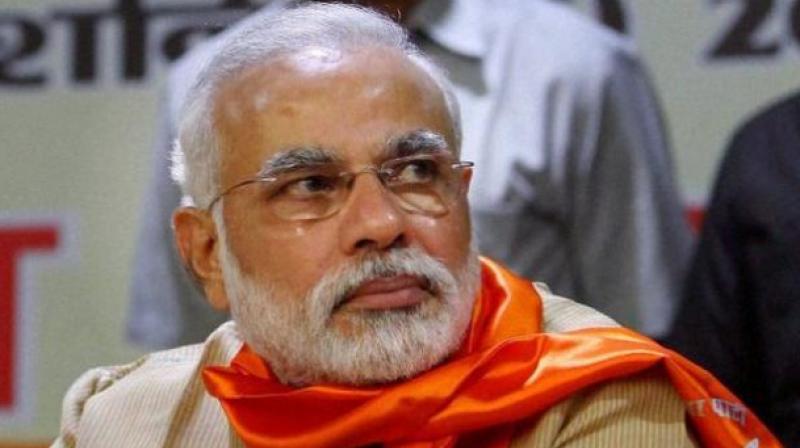NDA win decisive over miserable failure of Congress, regional parties
On the Congress-led UPA side, the situation by 12 noon has shown that it did not gain much from last time.

It is a decisive win for Prime Minister Narendra Modi, the BJP and the NDA. And Modi government 2.0 is on the anvil.
We need to explore the reasons too.
On the Congress-led UPA side, the situation by 12 noon has shown that it did not gain much from last time. And regional parties are on the decline except for YSR Congress in Andhra, BJD in Odisha, TRS in Telengana and DMK in Tamil Nadu (largely in South India). The Left is totally left out of the ensuing Lok Sabha.
What explains the opposition campaign fizzling out?
The critical strong points of the Congress challenge were all mistimed.
The manifesto and its core proposal of NYAY (Basic Minimum Income for the marginalised) were late in the day, and could not be communicated well to the grassroots by the party which had little in the form of organised grassroots apparatus and always dependent on mass media to do its talking, which the media in this election was not willing to, being heavily influenced by those in power. Second, Priyanka
Gandhi coming late did not very much help beyond enthusing UP Congress cadre, she not contesting and not even campaigning in states where Congress just came into power (MP, Chattisgarh and Rajasthan).
This was a crucial mistake. Even MP strongman Jyotiraditya Scindia being engaged largely in Western UP campaign due to Kamal Nath’s antagonism towards him was a poor strategy.
Third, the collective opposition to communal politics and polarisation of BJP could not be forged by the opposition forces. Congress floundered badly in forging an alliance in Bengal (with Left or TMC), Haryana (with JJP and AAP), Delhi (with AAP) and UP (with SP-BSP). The need was for all to combat
BJP and not restrict each other’s sphere of influence.
Fourth, absence of a single face of the opposition and lack of a coherent national strategy of all anti-BJP forces are so telling in the total tally today. Leaving the three critical newly won states of Rajasthan, MP and Chattisgarh purely to the local satraps and away from a national strategy of joint opposition, was a crucial mistake of Rahul Gandhi. Congress did not work to consolidate its strong points, and was wobbling to fight in the weaker pockets, except for Kerala.
What explains the clear win for BJP-led NDA?
Surely, a new set of social coalitions has evolved by the Sangh parivar which also involves the Dalits and OBCs contrary to their expectations before the elections.
The UP fiasco of the opposition shows that transfer of votes between SP and BSP did not happen and BJP could garner a large part of the votes of non Jatav Dalits and non Yadav OBCs.
BJP could also polarise a large part of the Hindu voters in Bengal and central India irrespective of castes either on local issues against the chief ministers or on issues of nationalism and Modi’s leadership.
Second, there reportedly controversial issues – the use of Election Commission, the Enforcement Directorate, the CBI, Pulwama and Balakot episodes etc also paid off for BJP to ensure the final results. For the record, Indira Congress did manipulate elections during its heyday in the past, too.
Needless to say, no single opposition face for the PM position, no coherent opposition national strategy, coupled with mobilisation of the entire Sangh parivar nationally and religious polarisation on
majoritarian identity grounds helped BJP ride the tide of a critical economic situation and failure on macro-economic fronts with joblessness, farm crisis, lower GDP and per capita growth than pre 2014 times, negative impact of demonetisation and GST etc.
What lies ahead hereafter?
While the de jure constitutional system of Indian polity is parliamentary a la British type, in effect and de facto India is turning into a presidential form of a policy (if still not so in governance) a la American type. This may further be consolidated. We may find constitutional amendments a galore, with regards to Articles 370, 35A, form of government, the goals of socialism and secularism in the preamble of the Constitution, etc.
There can be newer laws regarding triple talaq, mandir construction, national citizens’ registry and citizenship, sedition et al. These may further divide the society as well.
As for the opposition, regional parties shall have a setback and consolidation of the forces behind and around Congress. Though the lead of Congress is still limited to South India by and large, but a caste and region divided Opposition can never challenge BJP on its own, is obvious.
Even within the NDA, the BJP will usurp the politics of Shiv Sena both hinging on Hindutva, and of JD(U) as Nitish Kumar’s personal pull and effectiveness have come down drastically and it is BJP which is raring to go and be the leading partner in Bihar and Maharashtra by a long shot.
Now that political consolidation of power is almost complete across most of India for BJP, the theatre of political high drama shall be south of India next, where BJP is expected to replace the Left as the main opposition in Kerala, work in tandem with YSR Congress in Andhra and TRS in Telengana, and aim to oust the Cong-JDS government in Karnataka by fair or foul means. Also in Tamil Nadu, AIADMK will further degenerate and will play second fiddle to BJP going ahead for its limited relevance. Even BJD in Odisha will come to a broad understanding with BJP in the interests of the state, for now.
Further, Delhi and Bengal will be theatre of high drama too with state elections round the corner within a year or so in each. Expect a bigger round of violence in Bengal ahead with competitive violence and communalism of both the incumbent TMC and challenger BJP not willing to give an inch to each other. Expect AAP to go for a pitched battle for the mind of Delhi electorate with its governance track-record vis-a-vis BJP pledging Central support if elected to power.
Also, it is expected that the Modi Government 2.0 will have a much different composition of its council of ministers. And it will be interesting to note the new set of ministers who are expected to be younger on one side, and more pliant to Modi-Shah leadership on the other.
The writer is a leading media academic, a columnist and a political analyst in television news debates.

